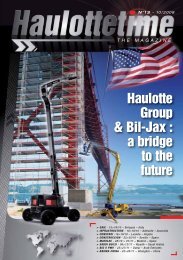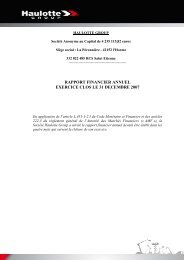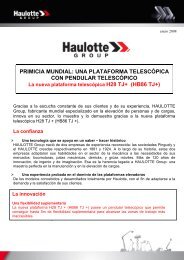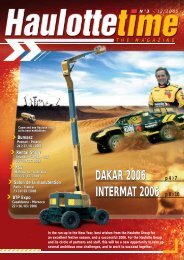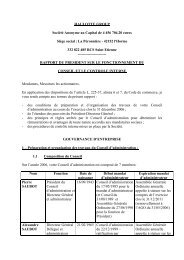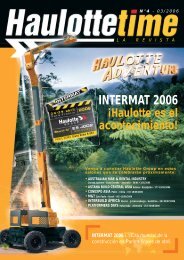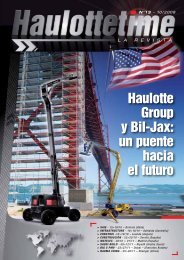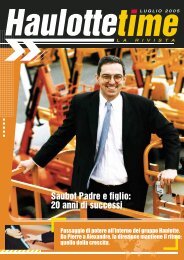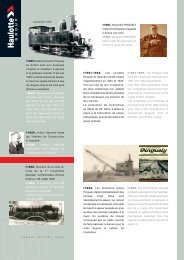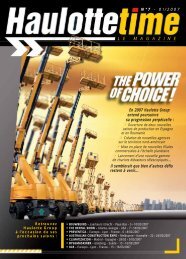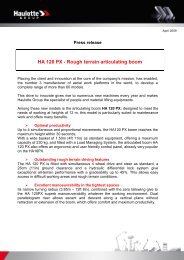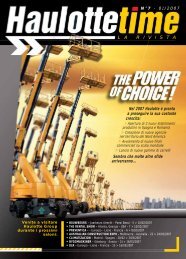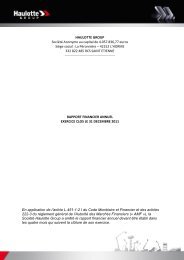2007 - Pinguely Haulotte
2007 - Pinguely Haulotte
2007 - Pinguely Haulotte
You also want an ePaper? Increase the reach of your titles
YUMPU automatically turns print PDFs into web optimized ePapers that Google loves.
<strong>2007</strong><br />
annual report # p89-90<br />
Consolidated financial statements of December 31st, <strong>2007</strong><br />
2.3 Basis of consolidation<br />
a) Subsidiaries<br />
Subsidiaries in which <strong>Haulotte</strong> Group<br />
S.A. exercises directly or indirectly exclusive<br />
control are fully consolidated. They are<br />
deconsolidated on the date that control<br />
ceases.<br />
b) Associates<br />
Companies in which the Group exercises<br />
significant influence without exercising<br />
control are consolidated under the equity<br />
method.<br />
Shares of companies not considered<br />
significant or in which the Group does<br />
not exercise significant influence are<br />
recognized as financial assets at fair value.<br />
The list of subsidiaries and equity<br />
associates is disclosed in note 6.<br />
2.4 Intercompany balances and<br />
transactions<br />
All intercompany balances and<br />
transactions between fully consolidated<br />
companies are eliminated.<br />
2.5 Foreign currency translation of<br />
financial statements of foreign<br />
subsidiaries<br />
The functional currency of the parent<br />
company, <strong>Haulotte</strong> Group S.A., is the euro<br />
that which is also the presentation currency<br />
in the consolidated financial statements.<br />
Financial statements of foreign subsidiaries<br />
are presented on the basis of their functional<br />
currency, i.e. the local currency.<br />
The financial statements of foreign<br />
companies for which the functional<br />
currency differs from the presentation<br />
currency (euro) are converted into the<br />
presentation currency as follows:<br />
- Assets and liabilities are translated at the<br />
year-end exchange rate;<br />
- Income statement items are converted<br />
at the average exchange rate for the<br />
period (based on the average monthly<br />
rate over 12 months).<br />
Exchange differences from the translation<br />
of the financial statements of the<br />
subsidiaries are recognized as a separate<br />
component of equity and broken down<br />
between the parent company share<br />
and minority interests.<br />
2.6Translation of transactions in foreign<br />
currency<br />
Transactions in foreign currencies are<br />
translated by the subsidiary in its<br />
functional currency at the exchange rate<br />
of the transaction date. At year-end,<br />
monetary items of the balance sheet<br />
denominated in foreign currencies are<br />
translated at closing exchange rates.<br />
Receivables and payables covered by<br />
foreign exchange hedges are translated<br />
at the hedge rate.<br />
Gains and losses on translation are<br />
recorded directly in the income<br />
statement under operating income as<br />
"exchange gains and losses" except<br />
foreign net investments as defined under<br />
IAS 21 for which exchange differences<br />
are recognized under equity.<br />
2.7 Business combinations<br />
Business combinations are recorded on<br />
the basis of the purchase method of<br />
accounting:<br />
- The cost of an acquisition is measured<br />
as the fair value at the date of exchange<br />
of assets given, liabilities incurred or<br />
assumed, plus any costs directly<br />
attributable to the combination.<br />
- Acquired identifiable assets, liabilities,<br />
and contingent liabilities are measured<br />
initially by the acquirer at their fair values<br />
at the acquisition date, irrespective of<br />
the extent of any minority interest. The<br />
excess of the cost of acquisition over<br />
the Group’s share in the fair value of<br />
the identifiable net assets is reviewed<br />
for allocation to intangible assets if<br />
necessary. The unallocated residual<br />
amount is recorded as goodwill. If the<br />
Group's share in the fair value of the<br />
acquired identifiable net assets exceeds<br />
the cost of acquisition, that difference<br />
is recognized directly in the income<br />
statement (see note 3.1).<br />
2.8 Segment reporting<br />
A business segment is a group of assets<br />
and operations engaged in providing<br />
products or services subject to risks and<br />
returns different from those of other<br />
business segments.<br />
A geographical segment is a group<br />
of assets and operations engaged in<br />
providing products or services in a<br />
particular economic environment subject<br />
to risks and returns different from those<br />
of segments operating in other economic<br />
environments.<br />
Note 3<br />
Principles and methods for the<br />
valuation of key balance sheet<br />
aggregates<br />
3.1 Goodwill<br />
Any excess of the cost of an acquisition<br />
over the Group’s share in the fair value<br />
of the identifiable net assets of the<br />
acquired entity at the acquisition date is<br />
recorded in the balance sheet as goodwill.<br />
Negative goodwill or badwill is<br />
recognised immediately under operating<br />
income as a gain and no later than 12<br />
months after verifying the correct<br />
identification and valuation of acquired<br />
assets and liabilities.<br />
Goodwill is not amortized but is subject<br />
to impairment tests when there exists<br />
an indication of impairment and at least<br />
once a year on the basis of the present<br />
value of future cash flows of the entity<br />
defined as a Cash Generating Unit (CGU).<br />
An impairment loss is recognized when<br />
the net present value of future cash flows<br />
is lower than the carrying value. This<br />
impairment loss, when applicable, is<br />
recorded under operating income in a<br />
distinct line "Badwill/impairment of<br />
goodwill".



